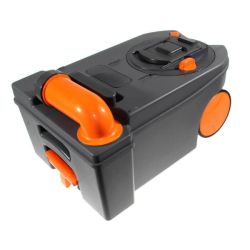Cassette Toilet - the do's with your poo's

Cassette Toilet - the full story
A cassette toilet is a portable and self-contained toilet system commonly used in most modern motorhomes. It consists of two main components: the toilet bowl and the waste-holding tank (cassette).
The toilet bowl of a cassette toilet operates similarly to a regular household toilet. It has a seat, a flush mechanism, and a water reservoir. Some models use a manual hand pump or an electric pump to flush water into the bowl after use.
This is where the waste is collected. The waste-holding tank is typically located directly below the toilet bowl. It is designed to be easily removable for emptying and cleaning. This is also the place were you would add additional chemicals to help to break down the solid and lessen the smells.
When a person uses the cassette toilet, they sit on the seat and perform their normal bodily functions. After use, they typically press a flush button or lever to rinse the bowl with a small amount of water. Some models might have a rotating blade or mechanism that helps break down the waste and toilet paper.
The waste in the cassette toilet tank breaks down through a combination of factors:
-
Chemicals: Many cassette toilets use specialized chemical solutions that are added to the waste-holding tank. These chemicals serve multiple purposes, such as controlling odors, breaking down solids, and promoting the decomposition of waste.
-
Agitation: Some cassette toilets incorporate a blade or paddle mechanism that is activated during flushing. This helps in breaking down solid waste and mixing it with the chemical solution, aiding in decomposition.
-
Time: Over time, the waste in the holding tank undergoes a natural process of decomposition, similar to that in a traditional septic system or sewage treatment plant. Bacteria present in the waste help break down organic materials.
When the waste-holding tank is full or when you're ready to dispose of the waste, you remove the cassette from the toilet. The waste can be emptied into a designated sewage dump station or toilet facility. Manufacturers usually provide guidelines on how to clean and maintain the cassette toilet, including rinsing out the tank and adding fresh chemical solution.
While cassette toilets are convenient and portable, there are some maintenance considerations and potential issues to be aware of. If the chemical solution is not used properly or if the toilet is not cleaned regularly, odors and buildup can occur. Additionally, improper disposal practices can harm the environment.
Never use household detergents to clean the toilet: they may contain bleach, which can cause damage to the seals and plastic. Use a dilute warm water solution of washing up liquid, or: Thetford Bathroom Cleaner
We advise that when cleaning the seal and blade you use Thetford bathroom cleaner and rinse with water.
NEVER use household cleaners as they could cause irreversable damage to the seal and other parts.
We recommend that you spray the seal economically with Thetford Mainenance Spray which will ensure a smooth operation of the blade, protects the seal and prevents adhesion between the blade and seal. Alternatively olive oil can be used. NO other vegetable oils or vaseline should be used as they may cause problems.
When putting the toilet into storage or not using for a long period of time (as you may be doing at this time of year!), then the seal should be kept clean and lubricated. The blade of the toilet should also be kept open to prevent the seal sticking to the blade.
The rest of the toilet can be safely and effectively cleaned with Thetford bathroom cleaner.
We advise draining the fresh watertank prior to travelling. Anti-freeze should not be required if the caravan/motorhome is heated.
If you do not wish to use anti-freeze, brands containing the following substances may be used,
-Mono-propylene glycol
-Ethylene glycol
-Mono-ethylene glycol
-Propane-diol
-Glycerol
-Ethane-diol
-Glycol
NEVER use alcohol based anti-freeze, i.e Methanol, Ethanol and Iso-propanol.
And here is a few tips from Thetford
The seats and covers of all Thetford toilets can be removed to make cleaning the unit easier. Simply hold the seat and cover together and pull upwards away from the toilet.
Never use household detergents to clean the toilet: they may contain bleach, which can cause damage to the seals and plastic. Use a dilute warm water solution of washing up liquid, or: Thetford Bathroom Cleaner.
If you won't be using the caravan for some time, give the toilet a thorough clean, making certain that you dry both the lipseal and blade, then spray them lightly with Thetford Maintenance Spray. Leave the blade in the open position to minimise the risk of the seal sticking to it.
DO NOT pour Aqua Kem into the holding tank through the blade hole: always add it via the pouring spout.
DO NOT shake the holding tank violently when rinsing it, as this can dislodge the float arm. A gentle swirling action and two or more rinses, as required, will ensure the tank is thoroughly clean.
When charging the holding tank add two litres of water to the Aqua Kem. This minimises the risk of waste "Pyramiding".
Drain down the fresh water chamber during winter lay-ups to prevent the possibility of frost damage.
Add Aqua Rinse to units which have their own fresh water tanks, It ensures a better flush preventing staining.
Toilet chemicals for motorhomes are used in portable toilets or holding tanks to help break down waste, control odours, and facilitate the overall sanitation process. The terms "pink," "blue," and "green" are often used to describe different types of toilet chemicals, each with specific functions and properties. However, it's important to note that the specific formulations and colours can vary between brands and manufacturers. Here's a general overview of the differences:
Pink Toilet Chemical
- - Pink chemicals are typically designed for breaking down solid waste and toilet paper in motorhome holding tanks.
- - They contain enzymes and bacteria that aid in the decomposition of organic matter, helping to reduce the formation of clogs and keeping the tank contents flowing smoothly.
- - Pink chemicals can also help control odours by neutralizing the foul smells associated with waste decomposition.
Blue Toilet Chemical
- - Blue chemicals often serve a similar purpose to pink chemicals, focusing on breaking down waste and controlling odours.
- - They may contain similar enzyme and bacterial formulations to aid in waste decomposition.
- - The blue colour itself can help mask the appearance of waste in the toilet tank, creating a more visually appealing environment.
Green Toilet Chemical
- - Green chemicals may have a more environmentally friendly formulation compared to traditional pink or blue chemicals.
- - They might contain natural or biodegradable ingredients that are safer for the environment and more eco-friendly.
- - Like pink and blue chemicals, green formulations can also help break down waste and control odours in the holding tank.
When choosing a toilet chemical for your motorhome, consider your specific needs and preferences. Some motorhome owners prefer specific colours or formulations based on their experiences and requirements. It's also essential to follow the manufacturer's instructions and guidelines for proper usage to ensure effective waste breakdown, odour control, and overall hygiene in your motorhome's toilet system. Always prioritize safety and environmental considerations when selecting a toilet chemical.
- This immediately creates “suction” at the valve opening, causing fresh air to be drawn in. Odours arising during use are therefore drawn in with the air and directed outside. The inward flow of air also behaves like a seal and fully prevents any unpleasant biogases from rising out of the tank. This means more air (oxygen) is sucked into the cassette with each use. The flushing process also adds water each time.
- The system switches off automatically when the toilet valve is closed, but continues to provide permanent aeration – as the oxygen supply – through a pipe or hose connection that is always open to the outside, thereby promoting the decomposition process.
SOG is a solution for eliminating toilet odours even without sanitary additives
On some toilet system like 'Thetford C402' they recommend not to travel with more than a few litres to avoid damage. That said I am yet to find someone who has caused any damage to there toilet in this way.
The legality of emptying your motorhome toilet down a regular drain varies depending on your location and local regulations. In most places, it is not legal or advisable to empty your motorhome toilet waste down a regular drain. Here's why:
Environmental Regulations:
Many areas have strict environmental regulations that prohibit the discharge of blackwater (sewage) from motorhomes into municipal sewer systems or stormwater drains. This is because untreated sewage can have negative impacts on water quality and the environment.
Plumbing and Infrastructure:
Dumping motorhome waste into a drain can cause blockages or damage to plumbing and sewage systems. Municipal sewage systems are not designed to handle the types of waste and chemicals found in motorhome toilets.
Health and Safety:
Improper disposal of waste can pose health and safety risks to the public and those working in the sewage treatment process.
To ensure compliance with local laws and to protect the environment, it's essential to use designated motorhome dump stations or approved waste disposal facilities for emptying your motorhome toilet. These facilities are equipped to handle motorhome waste and are designed to protect the environment.
Always check the local regulations and ordinances in the area where you plan to empty your motorhome toilet to ensure that you are following the law and being environmentally responsible. Violating these regulations can result in fines and legal consequences.
Motorhome / Caravan toilet paper and the toilet paper typically used at home are designed for different purposes, and there are some key differences between the two:
Dissolvability:
Motorhome/Caravan toilet paper is designed to dissolve more easily in water than regular household toilet paper. This is important in motorhomes and caravans, where waste is often managed by holding tanks that need to be emptied. Regular toilet paper can be more resistant to breaking down in water, which can lead to clogs and problems with the plumbing system.
Ply and thickness:
Motorhome/Caravan toilet paper is often thinner and has fewer plies than household toilet paper. This design helps it break down more easily in water and reduces the risk of clogs in plumbing systems.
Chemicals and fragrances:
Some motorhome/caravan toilet papers are designed to be biodegradable and environmentally friendly, and they may not contain the same chemicals or fragrances as some brands of household toilet paper. This is important for those who want to minimize their environmental impact and avoid adding harmful chemicals to waste systems.
Comfort and softness:
Household toilet paper is often designed with comfort and softness in mind, while motorhome/caravan toilet paper may sacrifice some of these qualities in favor of dissolvability and practicality. Motorhome/Caravan toilet paper may be less luxurious to use.
Cost:
Motorhome/Caravan-specific toilet paper can sometimes be more expensive per roll than regular household toilet paper. This cost difference is due to the specialized design and the need for it to meet the requirements of plumbing systems.
Availability:
Motorhome/Caravan toilet paper may not be as readily available as regular household toilet paper, which can be found in most stores. You might need to purchase motorhome/caravan-specific toilet paper from specialty RV supply stores or online.
In summary, Motorhome/Caravan toilet paper is designed to address the unique needs and challenges of Motorhome/Caravan, such as easy dissolvability and waste tank management, while household toilet paper prioritizes comfort and softness. When using an Motorhome/Caravan, it's generally recommended to use Motorhome/Caravan toilet paper to avoid potential plumbing issues and clogs.

